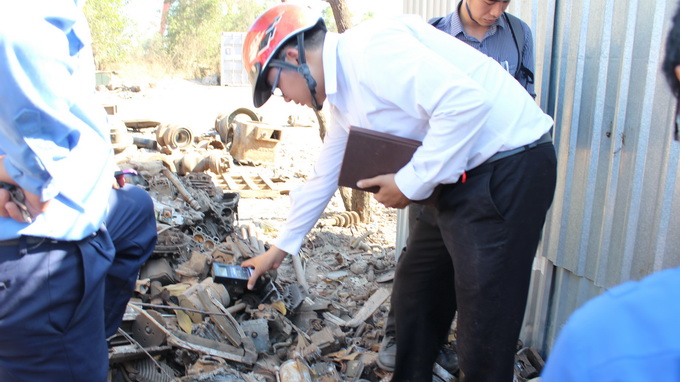Authorities in the southern coastal province of Ba Ria-Vung Tau are leaving no stone unturned in search of a piece of radioactive equipment that has possibly gone missing for more than three months.
Police officers are even looking for the radioactive source at facilities that collect scrap, besides running announcements on local media, Bui Van Thao, deputy director of the provincial Department of Public Security, said Monday.
The lost equipment belonged to a steelmaking plant operated by Pomina JSC, which only notified the province’s administration of the loss on Wednesday last week, more than three months after it reportedly disappeared.
The lost material, scientifically known as the Cobalt-60, was among five radioactive sources Pomina imported in 2010 to measure liquid steel levels at its steel casting plant.
The last time the equipment was confirmed to remain within the Pomina facility was late last year, the company admitted in a report.
One of the production lines of the plant was out of order at that time, and the radioactive source was removed and has not been handled by the steelmaker since, according to the report.
Pomina only realized the radioactive source was gone in March when a new employee took charge at the company’s radioactive safety management department.
Minister of Science and Technology Nguyen Quan signed Monday an urgent dispatch urging the Ba Ria-Vung Tau administration to find the lost radioactive source.
Cobalt-60, or 60Co, is a synthetic radioactive isotope of cobalt with a half-life of 5.2714 years. It is produced artificially in nuclear reactors.
“It’ll be very hazardous if this radioactive source is destroyed, deliberately or accidentally,” warned Dr. Nguyen Duc Thanh, former director of the Ho Chi Minh City nuclear center.
A radioactive source is usually wrapped in metal but when the cover is broken, the radioactivity will be leaked and damage the environment, Thanh said.
After entering a living mammal, such as a human being, some 60Co is excreted in feces, whereas the remainder is taken up by tissues, mainly the liver, kidneys, and bones, where the prolonged exposure to gamma radiation can cause cancer, according to the U.S. Environmental Protection Agency.
The Ba Ria-Vung Tau Department of Science and Technology is soliciting information about the lost radioactive material from members of the public and promises rewards for those who find it.
Like us on Facebook or follow us on Twitter to get the latest news about Vietnam!

















































